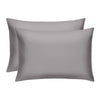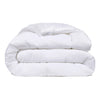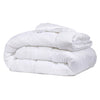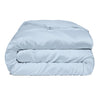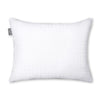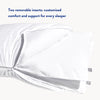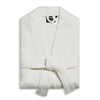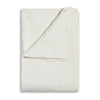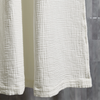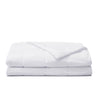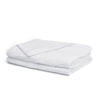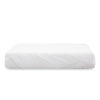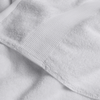The Daily Miracle
Duvet Vs Comforter: Which Is Right for Your Bed?
Published
October 08, 2024
Author
John Tsenekos

Your bed is your sanctuary, and the right bedding can turn it into a cozy haven where you can unwind and recharge. But when it comes to a duvet vs comforter, which one should you choose? Duvets and Comforters each have their unique features and benefits, and choosing the right one can really impact your comfort and ultimately your sleep. This article will explore the features of both options, guiding you to make the best choice considering your comfort and sleep quality. Whether you prefer the versatility of a duvet or the simplicity of a comforter, you'll find all the information you need to make an informed decision.
What is a Duvet?
A duvet is a soft, flat bag filled with down feathers or synthetic fibers, designed to keep you warm and cozy. Duvets are designed to be used with removable duvet covers, which makes it easy to change the styles of your bedding and keep your duvet clean. Duvets are known for their warmth due to the heavier filling and offer great aesthetic variety with interchangeable covers. The downside of a duvet is that the duvet cover must be purchased separately and it must fit the exact size of the duvet, adding an extra cost.
Pros of Duvets:
- Versatility: Duvets are highly versatile, offering a wide range of options for customization. Duvet covers come in many colors and patterns, allowing you to effortlessly update the look of your bed.
- Comfort: Duvets are incredibly cozy, making them perfect for snuggling up in bed. They provide an extra layer of warmth during colder months, ensuring you stay comfortable throughout the night.
- Protection: Using a duvet cover helps protect your duvet from dirt, dust, and wear and tear. This added layer of protection can significantly extend the life of your comforter, saving you money in the long run.
- Cleaning: One of the biggest advantages of duvets is their ease of cleaning. The duvet cover can be easily removed and washed in most home washers and dryers.
- Maintenance: Duvets require less frequent cleaning compared to other blankets because they are tucked away inside the cover. This means you can enjoy a clean and fresh bed without the hassle of constant washing.
- Warmth: Thanks to their heavier filling, duvets often provide more warmth than comforters, making them perfect for colder nights.
Cons of Duvets:
- Challenging to Insert: Changing duvet covers can be tricky and time-consuming. (Read our blog on how to put on a duvet cover for helpful tips)
- Movement Inside the Cover: The filling may shift inside the cover if not properly secured, leading to uneven warmth.
- Initial Cost: Duvets and their covers can be more expensive upfront compared to comforters. Especially since you should also purchase a duvet cover.
- Maintenance: While the cover is easy to clean, the duvet itself may require a professional cleaning every now and then.
- Storage Space: Duvets can be bulky and may require more storage space when not in use.
What is a Comforter?
Similar to a duvet, a comforter is a thick, quilted blanket filled with materials like down feathers or synthetic fibers, and is designed to keep you warm and cozy. Unlike duvets, comforters are typically sewn through to keep the filling evenly distributed, which helps maintain consistent warmth. They come in a variety of colors and patterns, eliminating the need for a separate cover. Comforters are easy to use since they don't require an additional cover. Hot sleepers can learn how to sleep cooler and also benefit from using a cooling comforter.
Pros of Comforters:
- Warmth: Ideal for cold sleepers or those living in colder climates, comforters provide excellent warmth.
- Style: Available in a wide range of colors and designs, comforters can add a personal touch to your bedroom decor.
- Breathability: Comforters are designed to be soft and allow air to circulate, enhancing comfort.
- Lightweight: Less bulky than blankets and duvets, comforters are easy to handle and manage.
- Easy to Clean: Many comforters are machine-washable, making them convenient to maintain.
- Affordability: Generally more affordable than duvet covers and inserts, comforters offer great value.
- Ready to Use: Comforters come ready to use straight out of the bag, with no need for additional assembly.
- Layered Look: They can create a stylish, layered look for your bed.
- All-Weather Options: Some brands offer comforters suitable for all seasons, providing year-round comfort and cooling effects during warmer months.
- Long-Term Investment: With proper care, comforters can last for many years.
- Variety of Materials: The shell of a comforter can be made from various materials, including cotton, silk, polyester, or fabric blends. Natural materials like cotton are soft and breathable, while synthetic fibers tend to retain heat.
- Cooling Technology: Some brands make cooling comforters for hot sleepers that can help keep temperature regulated throughout the night.
Cons of Comforters:
- Frequent Cleaning: Since comforters are directly exposed to dirt and dust, they may require more frequent washing compared to duvets.
- Limited Design Flexibility: Unlike duvets with interchangeable covers, comforters offer less flexibility in changing the look of your bedding.
- Heat Retention: Synthetic-filled comforters can retain heat, which might be uncomfortable for hot sleepers.
- Difficulty to Dry: Due to their thickness, comforters can take a long time to dry down completely after washing.
- Less Customizable: You can't easily change the filling or material inside a comforter, limiting customization options.
- Potential for Clumping: Over time, the filling in a comforter can shift or clump, leading to uneven warmth distribution.
Duvet Vs Comforters: What Are The Differences?
Duvet Vs Comforter: Comparison Chart
| Feature | Duvet |
Comforter |
| Structure | Separate insert and cover | Single-piece bedding |
| Material | Filled with down, feathers, or synthetic fibers | Made with synthetic or downfilling |
| Appearance | Typically bulkier and designed to be cozy | Slimmer, lighter design |
| Care | The cover is washable frequently, while the insert needs less cleaning | Easier to clean since no cover needs removal |
| Price | Tends to be a higher cost than comforters | Prices can vary greatly, from budget-friendly to premium options |
Duvet Vs Comforter: Key Differences
Warmth
When it comes to warmth, duvets generally provide more insulation due to their heavier filling, which often includes down or feathers. This makes them ideal for colder climates or for those who tend to get cold at night. Comforters, on the other hand, offer consistent warmth but may not be as insulating as duvets, much like how quilts provide a less insulated option. They are often filled with synthetic fibers, which can be less warm but more breathable. For people who get too hot at night, there are also cooling comforters that help regulate the temperature when you sleep.
(Read more on how do cooling blankets work to learn all about the cooling technology).
Maintenance
Maintenance is another key difference between duvet vs comforter. Duvets come with removable covers that can be easily machine-washed at home, making them convenient to clean. The duvet itself, however, may require professional cleaning. Comforters are usually machine-washable but may need more frequent washing since they are directly exposed to dirt and dust, which can break down the fabric over time.
Versatility
In terms of versatility, duvets have the upper hand. You can easily switch out the duvet cover without buying a new duvet to match different seasons, moods, or decor changes. This allows for greater customization in design and style. Comforters, while available in various colors and patterns, do not offer the same level of versatility, making them a less flexible alternative. Once you choose a comforter, you're generally committed to that design. If you frequently enjoy updating the look of your bedroom, a duvet offers more flexibility.
Ease of Use
When comparing ease of use in a duvet vs comforter, comforters are generally simpler. They come ready to use straight out of the bag and do not require an additional cover. Duvets, however, need to be inserted into a cover, which can be a bit tricky and time-consuming. This makes comforters a more straightforward option for those who prefer minimal fuss.
Cost
Cost is another factor to consider while exploring duvet vs comforter alternatives. Duvets and covers can be more expensive upfront, but they offer long-term value due to their durability and customization. While comforters are generally more affordable initially, they may need to be replaced more frequently, especially if they are not maintained with proper care.
Duvets vs Comforters: Which One Should You Choose?
When deciding between duvets vs comforters, consider your personal preferences, lifestyle needs, and whether you prefer down or synthetic filling. If you value warmth, customization, and easy maintenance, a duvet with interchangeable covers might be the best choice for you. On the other hand, if you prefer simplicity, affordability, and ready-to-use alternatives, a comforter could be more suitable. Think about factors like how often you want to change the look of your bedding, how much effort you're willing to put into cleaning, and whether you need extra warmth. By weighing out these points, you can choose the bedding that will be the most comfortable and convenient to elevate your sleep experience.
FAQs: Duvets vs. Comforters
Can a Duvet Be Used as a Comforter?
Yes, a duvet can be used as a comforter, but there are some differences to consider. A duvet is essentially a thicker, more insulated blanket designed to be used with a removable cover, which makes it versatile and easy to maintain. When used without a duvet cover, a duvet performs much like a comforter, providing warmth and comfort. However, because duvets are typically heavier and more insulating, they might be warmer than a standard comforter. Additionally, without the cover, you lose the aesthetic flexibility and protection that a duvet cover provides. So, while a duvet can serve as a comforter, using it with its cover offers more benefits in terms of maintenance and style.
Do Comforters Last Longer Than Duvets?
The longevity of comforters versus duvets largely depends on how well they are maintained and the quality of the materials used. Generally, duvets can last longer than comforters because they are protected by removable covers, which shield them from dirt, dust, and wear and tear. This cover can be easily washed, reducing the need to clean the duvet itself frequently, thereby extending its lifespan. Comforters, on the other hand, are directly exposed to these elements and may require more frequent washing, which can lead to quicker wear and tear. However, high-quality comforters that are well-cared for can also last a long time. Ultimately, both options can be durable and a great choice as long as proper care is taken into effect.
What’s the Best Option for Allergy Sufferers?
For allergy sufferers, the best option is typically a duvet with a hypoallergenic cover and filling. Duvets with synthetic fillings, such as microfiber or polyester, are less likely to harbor allergens like dust mites compared to natural fillings like down or feathers. Additionally, the removable duvet cover can be frequently washed, helping to keep allergies at bay. Look for covers made from tightly woven fabrics and get a mattress protector that acts as a barrier against dust mites and other allergens. Comforters can also be a good choice if they are labeled hypoallergenic and are machine-washable, as you can regularly clean them for optimal freshness.
Which Bedding Should I Use?
Yes, the top layer of your bedding is essential, but so is your bedding set. With a luscious comforter or duvet, you’ll need the sheet set to match. A complete sheet set includes the following:
- Top sheet
- Pillowcase
- Pillow shams
- Fitted sheet
- In some cases, a comforter
If you’re in the market to prioritize your sleep and overall health, we suggest keeping the quality of your bedding as a must-do. Your sleep environment, which includes your bedding, can significantly affect your sleep and overall health. Opting for the softest, most plush sheets can help you get the shut-eye you deserve.
The Bottom Line
Choosing between a duvet and a comforter ultimately comes down to your personal preferences and lifestyle needs, as each option has pros and cons. When deciding between the two, consider your needs for warmth, maintenance, versatility, ease of use, and cost. Duvets are great because they are warm, easy to use, and can be washed with their removable covers. This makes them a good choice for people who like to change their bedding often and need more insulation. Comforters, on the other hand, are simpler to use, more affordable upfront, and come ready to use straight out of the bag, making them ideal for those who prefer a no-fuss option.
If you want a good comforter, consider the Miracle Made® Cooling Comforter. It is known for its great comfort and durability. It is made with instant-cool, temperature-regulating, and moisture-wicking fabric so you wake up cool, dry and rested. Whether you choose a duvet or a comforter, the key is to select the option that best fits your needs for comfort, style, and convenience. Happy sleeping!
Sources:
How to choose the best duvet: 10 things you need to know | Scooms Ltd
Why Do I Get So Hot When I Sleep? | Sleep Foundation
Allergy Bedding FAQs | AchooAllergy


